
St.George Bank is an Australian bank with its headquarters in Sydney. Since a 2008 merger, the bank has been part of Westpac, having previously been an independent legal entity. In 2010, St.George was deregistered as a company and ceased to be a standalone authorised deposit-taking institution.

The Bank of New South Wales (BNSW), also known as The Wales, was the first bank in Australia. It was established in 1817 in Sydney. During the 19th century, the bank opened branches throughout Australia and New Zealand, expanding into Oceania in the 20th century. Throughout it history it merged with and purchased many other financial institutions. In 1981 it merged with the Commercial Bank of Australia and was renamed Westpac on 4 May 1982.

The State Savings Bank Building is a heritage-listed large bank building and commercial offices situated at 48–50 Martin Place, in the Sydney central business district in the City of Sydney local government area of New South Wales, Australia. It was designed by Ross & Rowe Architects and Consulting Engineers and built from 1925 to 1928 by Concrete Constructions Ltd. It is also known as The Government Savings Bank of New South Wales, Commonwealth Bank building (former), and CBA Building. After several decades of use by the Commonwealth Bank of Australia, including as its headquarters from 1984, it was purchased by financial services company Macquarie Group in 2012, refurbished, and now serves as Macquarie's global headquarters as 50 Martin Place. It was added to the New South Wales State Heritage Register on 17 November 2000.

The Bank of New South Wales Building is a heritage-listed former bank building located at 33 Queen Street, Brisbane City, City of Brisbane, Queensland, Australia. It was designed by Hall & Devereux and built from 1928 to 1930 by F J Corbett & Sons. It is also known as Westpac Bank Building. It was added to the Queensland Heritage Register on 21 October 1992.

Bank of New South Wales Building is a former heritage-listed bank at 101–111 Flinders Street, Townsville CBD, City of Townsville, Queensland, Australia. It was built in 1887 by Denis Kelleher. It is also known as Australian Meat Industry Employees Union. It was added to the Queensland Heritage Register on 21 October 1992.

Westpac Bank Building is a heritage-listed bank building at 337–343 Flinders Street, Townsville CBD, City of Townsville, Queensland, Australia. It was designed by Hall and Cook and built in 1935 by Stuart Brothers (Sydney). It was added to the Queensland Heritage Register on 13 May 2004.
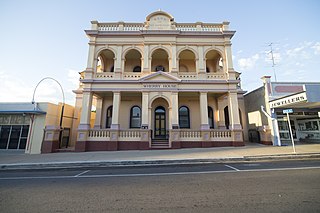
Bank of New South Wales is a heritage-listed former bank building at 34–36 Gill Street, Charters Towers City, Charters Towers, Charters Towers Region, Queensland, Australia. It was designed by Eyre & Munro and built in 1889 by Kelleher. It is also known as Wherry House. It was added to the Queensland Heritage Register on 9 November 2012.

The Old London Bank Building is a heritage-listed former bank building and boarding house and now guesthouse at 17 Sturt Street, Bourke, Bourke Shire, New South Wales, Australia. It was designed by Melbourne architectural firm Terry and Oakden and built from 1886 to 1888, with construction attributed to local builders/architects Perry and Hawken. The building now operates as the Gidgee Guesthouse. It was added to the New South Wales State Heritage Register on 2 April 1999.

The Union Bond Store is a heritage-listed former warehouse, bond store and Westpac bank branch and museum located at 47 George Street in the inner city Sydney suburb of The Rocks in the City of Sydney local government area of New South Wales, Australia. It was designed by John Bibb and built from 1841 to 1842. It is also known as Union Bond Store (former) and Westpac Bank. The property is owned by Property NSW, an agency of the Government of New South Wales. It was added to the New South Wales State Heritage Register on 10 May 2002.

139–141 George Street are heritage-listed former terrace houses and now shops located at 139–141 George Street in the inner city Sydney suburb of The Rocks in the City of Sydney local government area of New South Wales, Australia. It was built from 1881 to 1882. It is also known as three storey stone building. The property is owned by Property NSW, an agency of the Government of New South Wales. It was added to the New South Wales State Heritage Register on 10 May 2002.

107–109 George Street, The Rocks is a heritage-listed restaurant and former retail building, residence and bakery located at 107–109 George Street, in the inner city suburb of The Rocks in the City of Sydney local government area of New South Wales, Australia. It was built during 1860. It is also known as Rockpool Restaurant (former); and William Blue Dining. The property is owned by Property NSW, an agency of the Government of New South Wales. It was added to the New South Wales State Heritage Register on 10 May 2002.

The Sydney Water Head Office, now known as Kimpton Margot Sydney is a heritage-listed hotel, formerly an office building, located in the Sydney central business district in New South Wales, Australia. It was designed by Henry Budden & Mackey and built from 1938 to 1939 by Howie Moffat & Co, commonly called the Water Board Building and formally the Metropolitan Water, Sewerage and Drainage Board Headquarters. Following Sydney Water's relocation to Parramatta in 2009, it was converted into a hotel (as The Primus Hotel, part of a chain of hotels owned by the municipal government of Shanghai, while the adjoining 1969 office building was redeveloped to become the Greenland Centre. In 2021, Primus Hotel Sydney closed, and in 2022 the hotel re-opened as part of the Kimpton chain operated by IHG Hotels & Resorts.
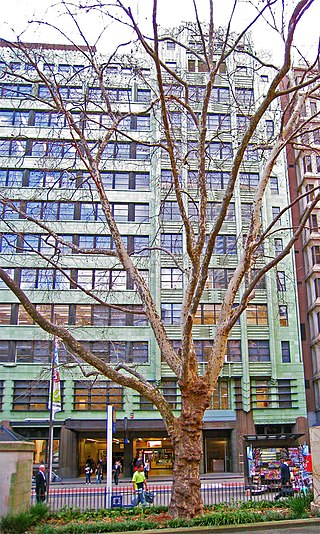
The Transport House is a heritage-listed office building located at 19-31 York Street in the Sydney central business district, in the City of Sydney local government area of New South Wales, Australia. It is also known as Railway House; Greenhouse; and the Wynyard SRA Offices. The property is privately owned. It was added to the New South Wales State Heritage Register on 2 April 1999.

107–109 Bathurst Street, Sydney is a heritage-listed former bank building and now KFC fast food restaurant located at 107–109 Bathurst Street, Sydney, New South Wales, Australia. The property is privately owned. It was added to the New South Wales State Heritage Register on 2 April 1999.
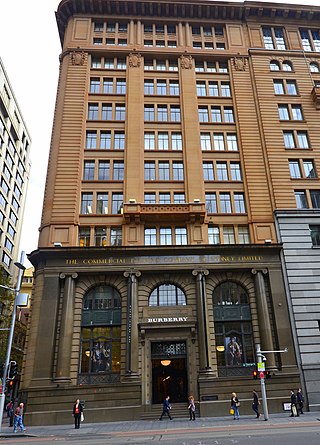
343 George Street, Sydney is a heritage-listed former bank building and now nine-storey retail and commercial premises. It is located at 343 George Street in the Sydney central business district, in the City of Sydney local government area of New South Wales, Australia.
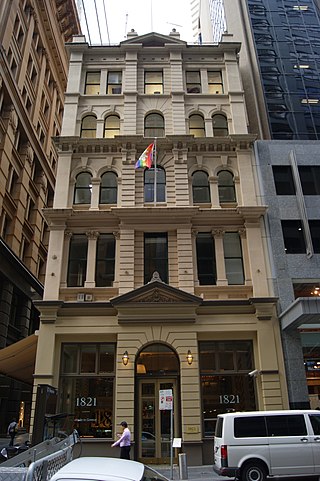
The Sydney Club is a heritage-listed club premises at 122 Pitt Street, in the Sydney central business district, in the City of Sydney local government area of New South Wales, Australia. It was designed by Mansfield Brothers and built from 1886 to 1887 by A & A Scott. It is also known as Million House. It was added to the New South Wales State Heritage Register on 2 April 1999.

The Trust Building is a heritage-listed office and commercial building and former hotel located at 72-72a Castlereagh Street, in the Sydney central business district, in the City of Sydney local government area of New South Wales, Australia. It was designed by firm Robertson & Marks and built from 1914 to 1916 by Stuart Brothers. It was added to the New South Wales State Heritage Register on 2 April 1999.

International House is a heritage-listed commercial building at 14-16 York Street, in the Sydney central business district, in the City of Sydney local government area of New South Wales, Australia. It was designed by Robertson & Marks and built during 1913 by Howie, Brown & Moffat, Master Builders. It is also known as Pomeroy House. It was added to the New South Wales State Heritage Register on 2 April 1999.
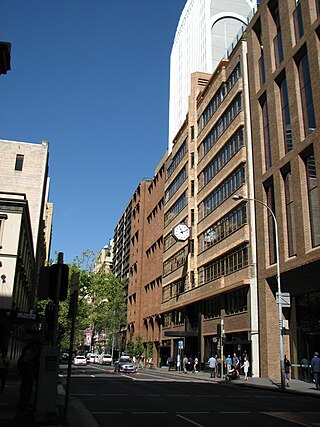
The Red Cross House is a heritage-listed former commercial building and now Australian Red Cross and blood transfusion centre located at 153-159 Clarence Street, Sydney, New South Wales, Australia. It was designed by Samuel Lipson, architect, in conjunction with Robertson and Marks and McCredie and built from 1937 to 1938 by Kell & Rigby. It was originally built for the firm of S. Hoffnung & Co.

354 George Street, Sydney is a heritage-listed retail and office building and former bank building located at 354 George Street, in the Sydney central business district, in the City of Sydney local government area of New South Wales, Australia. It was designed in various stages by Edward Raht, A. K. Henderson, Joseland & Gilling and Kevin Winterbottom and Assoc. and built in various stages from 1902 to 1937 by Loveridge & Hudson and Kell & Rigby. It is also known as ANZ Bank (former); ANZ Bank; United Permanent Building; 2 Martin Place; Paspaley Pearls; 354-360 George Street; and Bank of Australasia. The property is owned by Paspaley Pearls Properties P/L. It was added to the New South Wales State Heritage Register on 2 April 1999.























